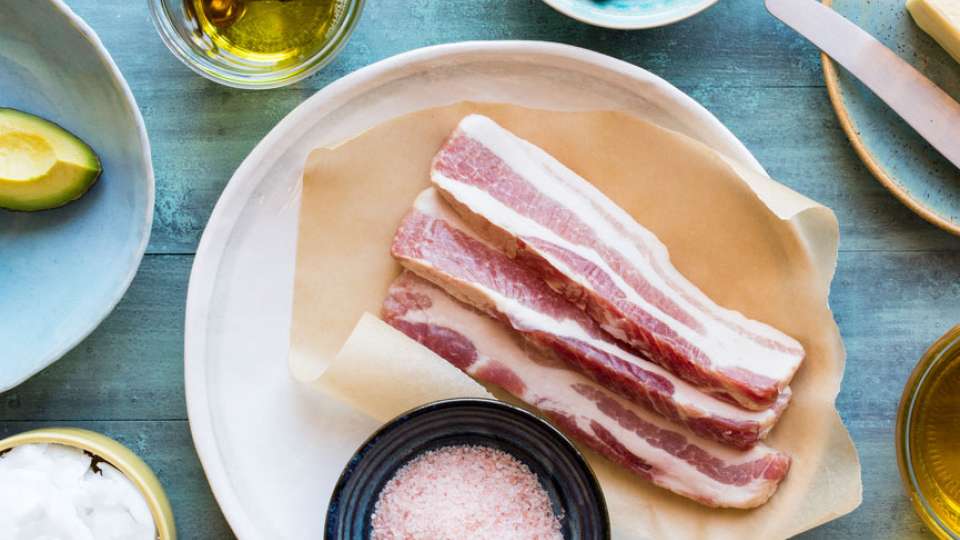
The keto diet was originally developed for kids with epilepsy. But when weight loss-minded adults caught wind of a diet that not only allowed but encouraged the consumption of bacon, butter and other fatty foods, it didn’t take long for it to become a trend.
What is the keto diet?
A ketogenic diet—or keto, for short—is a high fat, very low carbohydrate and moderate protein diet. The diet’s name comes from ketones, molecules formed when the body burns fat for its source of energy instead of carbohydrates.
On a more typical diet, your body converts the carbohydrates you eat into glucose for fuel. It either uses the glucose immediately or sends it to your liver and muscles where it is stored as glycogen for future use, explains Vanessa Imus, a registered dietitian at the Weight Loss Management Center at UW Medical Center-Roosevelt.
On the keto diet, without the carbohydrates your body usually uses to produce energy, your liver converts fat into fatty acids and ketone bodies, or ketones for short. This metabolic state of burning fat instead of carbohydrates for fuel is known as ketosis.
Ketosis is just another way of saying that you are no longer a carbohydrate-burning machine, but a fat-burning machine instead.
What makes keto so popular compared to other diets?
The high ratio of fat to protein to carbohydrate distinguishes the keto diet from other weight loss diets. It’s also what makes it so popular. You can eat high-fat foods that are more often considered diet-busters than boosters—like butter and bacon.
Some diets, such as Atkins, start off with a stage of ketosis and then slowly reintroduce carbohydrates. But even other low-carbohydrate diets don’t recommend the high-fat consumption of the keto diet.
“People become excited about the diet when they first hear about it. They think that maybe this is a diet they can succeed at without having to give up the high-fat foods they love,” says Imus.
How do you know when you’ve reached ketosis?
If the keto diet is all about ketosis, how do you know when you’re in it?
Your body’s transition from burning carbs to burning fat does not happen overnight. It takes about three to seven days to adjust, and the process leads to a state commonly known as the keto flu. Keto flu symptoms can include tiredness, nausea, dizziness, difficulty concentrating, insomnia, upset stomach, dehydration and fruity-smelling breath.
That fruity smell is acetone. Yup, the same acetone that’s in your nail polish remover. Acetone is one of the ketones released by your liver. Because it is the most volatile of the ketones, it diffuses into your lungs and is released when you exhale.
Fruity breath is a good indicator that you are in ketosis. But if it isn’t enough confirmation for you, you can buy strips to test the ketone levels in your blood or urine.
What are the cons of the keto diet?
Keto is not a diet that Imus recommends for weight loss.
It’s true that low-carb diets can lead to fast short-term weight loss, but most studies find that at a year or two out, people have put the weight back on. Imus sees a lot of people at the Weight Loss Management Center after they go off the keto diet and have put back on all the weight they lost (and then some).
And that’s not her only beef with the keto diet.
If you are at liberty to eat as much fat as you want, you are likely going to eat more saturated fats, which can be inflammatory. Heart disease, diabetes, many cancers and other diseases are caused or made worse by inflammation.
Worst of all, because the keto diet virtually eliminates carbohydrates from your diet, it eliminates most fruits, many vegetables and all the nutrients they contain—vitamins, minerals, fiber and phytonutrients, too.
“Anytime I see a diet that pretty much rules out an entire category of food—like carbohydrates—I say no. It’s too extreme,” says Imus. “As with most diets, you are either on the diet or off the diet, so it’s not teaching you a sustainable way of eating for the long term.”
The best way to lose weight and be healthy is to consume a balanced diet of unprocessed whole foods. Include a variety of high-fiber vegetables, fruits, legumes, nuts, seeds and lean proteins.
"Author Michael Pollan said it well when he said, 'Eat food, not too much, mostly plants,'" says Imus. "Being mindful of the body’s cues of hunger and fullness will help guide people in the direction of moderation."

 Healthy ideas for your inbox
Healthy ideas for your inbox





